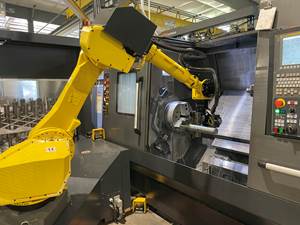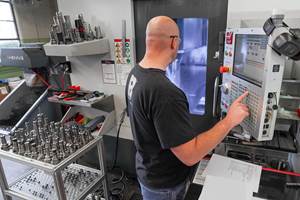Transfer Line Reduces Lead Time for Car Maker
To make bevel gears of different sizes with a three-minute line-cycle time, WMZ integrated three of its V300 machines with automation and measuring systems for reduced total lead time of 30 percent.
Share





By combining processes such as machining and measuring with automation, transfer lines can increase productivity. However, the complex and diverse requirements of manufacturing components for cars and other commercial vehicles can complicate the development of transfer lines for the automotive industry. Werkzeugmaschinenbau Ziegenhain (Schwalmstadt, Germany), a member of the DVS Technology Group, took on the challenge of creating and implementing a transfer line for a German commercial vehicle manufacturer that needed to be able to produce bevel gears in a fast line-cycle time. The solution has resulted in a 30 percent reduction in total lead time for the manufacturer by maximizing productivity.
Since Werkzeugmaschinenbau Ziegenhain (WMZ) specializes in machines designed to produce shaft-shaped components, the car maker reached out to the company to see if it could devise an integrated production solution that could combine several machining steps to completely machine bevel gears of different geometries while maintaining a line-cycle time of three minutes from forged blank to finished part.
WMZ chose three machines from its modular V300 series to comprise the transfer line, which also includes automation and measuring systems. Each machine was assigned to its specific machining task by selecting suitable tools.
“The possibility of having a customized solution devised specifically for the application with everything from a single source was one of the main reasons why the customer opted for WMZ,” DVS Managing Director Mario Preis says.
The transfer line starts when the blanks, which weigh between 6 and 40 kilograms, are placed on a conveyor system with a gripper that automates passage through the entire transfer line. The automation system reduces manual work because the parts do not have to be moved or stored in between machining steps. It takes the blanks to the first machine, where they are cut to length and centered. The machine has two flexible crown turrets with an HSK 63 interface for rigidity and drive power, while the centering clamps hold the workpieces with a wide clamping range to reduce the need for retooling.
A gantry loader moves the parts to the second machine, where they undergo roughing in four axes and finishing of the tapered head. The integrated, heavy-duty motor spindle is specially rated for the application, with drive power ranging to 124 kW for cutting depths as deep as 10 millimeters, the company says.
Finishing and gear cutting of the bevel gear journal in the hobbing process takes place in the third and final machine of the line. Combining turning and hobbing in a single clamping improves precision and efficiency. The bevels are said to have concentricity of less than 10 microns after finishing, and the hobbing unit developed by WMZ is said to produce splines with tolerances of less than 10 microns over balls. The hobbing unit’s 140-millimeter shift path is designed to maximize hobbing cutter use. A hydraulic shaft chuck and dolly combined with an SK 30 holder enable a change-over accuracy of 3 microns for easy retooling, the company says.
Once the bevel gears have run through all three machines, they are measured in an integrated measuring system with measured data feedback and automatic dimensional correction, which WMZ says has reduced the car maker’s rate of rejects. It also eliminates the need for the transfer line to run up to speed in preparation for mass production.
After measurement, the bevel gears are brought automatically to the customer’s two existing tooth-cutting machines for spiral tooth cutting. The bevel gear is then ready for installation.
Related Content
Using Automation to Reduce COGS and Stay Globally Competitive
Decade-long, multiphase automation investments lower operating costs and maintain technology lead in an increasingly competitive global market.
Read MoreSame Headcount, Double the Sales: Successful Job Shop Automation
Doubling sales requires more than just robots. Pro Products’ staff works in tandem with robots, performing inspection and other value-added activities.
Read MoreMedical Shop Performs Lights-Out Production in Five-Axes
Moving to five-axis machining enabled this shop to dramatically reduce setup time and increase lights-out capacity, but success relied on the right combination of workholding and automation.
Read MoreWhich Approach to Automation Fits Your CNC Machine Tool?
Choosing the right automation to pair with a CNC machine tool cell means weighing various factors, as this fabrication business has learned well.
Read MoreRead Next
How I Made It: Dennis Rymanowski
Dennis Rymanowski has worked at NSH USA for 60 years, with his passion for manufacturing living alongside his passion for his family’s polka band.
Read MoreA New Frontier in Surface Finish Control
What if your machine tool could measure surface roughness as it cuts? This article explores how in-process metrology is advancing from concept to reality, enabling real-time feedback, immediate detection of anomalies and new levels of control over surface quality. Discover the technologies making this possible.
Read More























